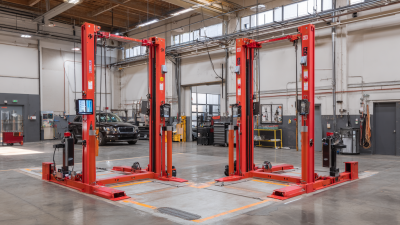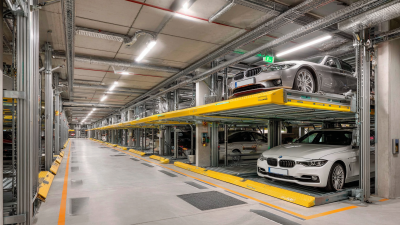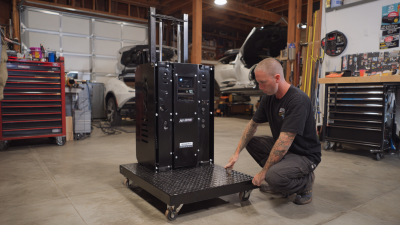How to Choose the Right Mobile Lift Car for Your Heavy Lifting Needs Based on Industry Metrics
Table of Contents
- Key Considerations for Selecting Mobile Lift Cars in Heavy Lifting Applications
- Understanding Industry Metrics that Influence Mobile Lift Car Performance
- Different Types of Mobile Lift Cars and Their Suitability for Various Industries
- Evaluating Load Capacity and Stability for Safe Heavy Lifting
- Assessing Mobility Features and Ergonomics for Operator Efficiency
- Maintenance and Safety Standards to Consider When Choosing Mobile Lift Cars
- Revolutionize Your Roadside Assistance with Portable Car Quick Lift AC Series: The Essential Tool for Every Driver
- FAQS
- Conclusion
- Related Posts
As more and more industries start relying on mobile lift cars for heavy lifting and moving materials around, picking the right lift isn’t just a nice-to-have — it’s essential for keeping things safe and running smoothly. I came across a report from Allied Market Research that said the global market for hydraulic lifts is expected to hit around $8.5 billion by 2026. That growth is largely thanks to tech improvements and the increasing demand in sectors like construction, manufacturing, and warehouses.

Companies like Yantai Tonghe Precision Industry Co., Ltd. are focusing on hydraulic control systems, cylinders, and mobile lifts, offering customized solutions to tackle all sorts of heavy lifting challenges. When you're choosing a lift, it helps to understand some key metrics — things like load capacity, how high it can lift, and how mobile it is. Making the right choice can seriously boost your operation’s efficiency and also keep things safer for everyone.
Ultimately, finding the perfect mobile lift car isn’t just about productivity; it’s about creating a safer work environment and sticking to industry standards and best practices.
Key Considerations for Selecting Mobile Lift Cars in Heavy Lifting Applications
When you're choosing a mobile lift car for heavy lifting jobs, there are a few key things you'll want to keep in mind. First off, the load capacity needs to match the weight and size of whatever you’re lifting — grasping this is super important for safety and making sure everything runs smoothly. If you underestimate the capacity, you run the risk of equipment failure or even accidents, and nobody wants that.
Then, you've got to think about the terrain and the environment where the lift will be used. Some jobs are on uneven ground or tight spaces, so you’ll need a lift that can handle those conditions. Features like adjustable height, good maneuverability, and sturdy build are often a must for different work sites.
Oh, and don’t forget about energy use and how you’re powering the lift — these factors can really add up in terms of costs and eco-friendliness. By weighing these things carefully against what your industry actually needs, you’ll be able to pick the right mobile lift car that gets the job done safely and efficiently.
Understanding Industry Metrics that Influence Mobile Lift Car Performance
When you're choosing a mobile lift cart, it’s really important to get a good feel for the industry metrics that actually impact how well it performs. Things like load capacity, lift height, and speed – they all matter. For instance, load capacity tells you how much weight the lift can handle safely; this can vary a lot depending on the model and what you plan to use it for. Plus, figuring out the maximum lift height is pretty crucial, especially if you need to reach those higher places regularly. And don’t forget about operating speed—if you're working in a busy environment, how fast the lift moves can make a real difference in how efficient your workflow is.
Another thing to look at is stability and safety features. They’re super important when it comes to reliable performance. Checking out the base design and whether the lift has good safety mechanisms can help prevent accidents and keep everything running smoothly. Also, it's worth considering what powers the lift—whether it’s electric, hydraulic, or pneumatic—as that can influence maintenance costs and overall operation expenses. Picking a mobile lift that ticks these boxes isn’t just about getting the job done faster; it’s also about staying safe and making sure it’s suited to your specific heavy lifting needs.
Choosing the Right Mobile Lift Car Based on Industry Metrics
| Metric | Description | Value | Importance Level |
|---|---|---|---|
| Lifting Capacity | Maximum weight the lift can handle | 1,500 kg | High |
| Lift Height | Maximum height to which the car can lift | 3.5 m | Medium |
| Power Source | Type of power used for operation | Electric | High |
| Weight of Lift Car | Total weight of the lift car itself | 800 kg | Medium |
| Working Environment | Conditions in which the lift will be used | Indoor/Outdoor | Medium |
| Safety Features | Built-in safety mechanisms | Yes | High |
Different Types of Mobile Lift Cars and Their Suitability for Various Industries
So, when you're picking out a mobile lift car, it’s pretty important to get a good handle on the different types out there and what they’re best suited for. For example, scissor lifts are great for stuff like construction work or maintenance calls. They give you a stable platform that can go pretty high and carry a decent load. Plus, their compact size means they can squeeze into tighter spaces, making them perfect for indoor projects or outdoor setups where you need to go up a bit.
On the other hand, boom lifts are more your go-to if you need that extra reach and more flexibility. Things like telecom setups or filming locations often need that. These lifts can extend their arms to dodge obstacles and reach some pretty impressive heights while staying safe and stable. Then there are transport platforms, which are super handy for industries like warehousing and logistics. They help you load and unload quickly, which keeps things moving smoothly in busy environments.
By thinking about what your industry actually needs and comparing those needs to the different lift options, you’ll be in a much better spot to choose the right one—so you get what works specifically for your heavy lifting jobs, without any guesswork.
Evaluating Load Capacity and Stability for Safe Heavy Lifting
When you're choosing a mobile lift car for heavy-duty lifting, it's really important to consider both how much weight it can handle and how stable it is. A report from the American Society of Mechanical Engineers (ASME) highlights that almost half of all workplace accidents involving heavy lifting are due to equipment that just isn’t up to the task. That’s why picking a model that meets industry standards is a big deal. Typically, these lift cars can handle anywhere from 1,000 to 10,000 pounds, depending on the job. Make sure the lift’s load capacity is actually higher than what you need to move — safety first, after all! You don’t want the equipment failing because it was overloaded.
Stability is another key factor you shouldn’t overlook. OSHA’s research shows that many lift-related accidents happen because the equipment isn’t stable enough. So, when scoping out a mobile lift, check if it has a wide base and a low center of gravity — these features really boost stability when you’re working. And it’s smart to look for lifts that meet the safety standards set out in ANSI/ASME B30.1. Those standards ensure the equipment can handle side forces without tipping over. By paying attention to both load capacity and stability, you’ll set yourself up for safer, more efficient lifting — no matter what industry you’re in.
Assessing Mobility Features and Ergonomics for Operator Efficiency
When you're picking out a mobile lift for heavy lifting jobs, it’s super important to look at how easy it is to move around and how comfortable it is to use. Stuff like how smoothly it glides, its weight, and size really make a difference—especially when you’re trying to squeeze it into tight spots or deal with uneven surfaces. A lift with good wheels that roll nicely lets you focus on the actual lifting, instead of fighting with the equipment. Plus, features like adjustable height and quick lowering options can make the whole process faster—something you definitely want in busy, high-pressure situations.

And don’t forget about ergonomics! It’s just as important to make sure the operator’s working comfortably. A well-designed lift will have padded handles, easy-to-understand controls, and adjustable platforms to fit different users. These little touches help cut down on physical strain, making work less exhausting and helping prevent injuries from awkward postures or repetitive movements. By paying attention to both mobility and comfort, companies can make sure their workers have the right tools to get those heavy jobs done safely and efficiently.
Maintenance and Safety Standards to Consider When Choosing Mobile Lift Cars
When you're picking out a mobile lift car for heavy lifting chores, it’s super important to keep safety and maintenance front and center. OSHA points out that about 20% of worker injuries in the manufacturing world happen because of material handling issues, so you really wanna make sure your equipment follows strict safety rules. Going with a mobile lift that meets the ANSI/ASSE A92.20 standards isn’t just about keeping folks safe — it also helps reduce accidents when you're lifting heavy stuff.
On top of that, regular maintenance is absolutely key to keeping things running smoothly and safely. The NFPA stresses that sticking to a good maintenance routine can seriously cut down on equipment failures. Think about doing monthly inspections and at least one major check-up each year, just like the ASME recommends. Choosing a mobile lift that ticks all these boxes isn’t just about safety; it can also boost productivity and save a bunch of money in the long run by preventing injuries and costly repairs.

Revolutionize Your Roadside Assistance with Portable Car Quick Lift AC Series: The Essential Tool for Every Driver
Revolutionizing roadside assistance has never been more accessible with the introduction of the LUXMAIN AC Series Quick Lift. This innovative tool is designed specifically for drivers who value efficiency and effectiveness in car maintenance. According to recent industry reports, roadside assistance services are experiencing a surge in demand, with a projected market growth of 3.5% annually over the next five years. The LUXMAIN AC series addresses this necessity, offering a compact and lightweight solution that can be easily stored and transported.
The LUXMAIN AC Series consists of two lifting frames and one power unit, allowing users to lift their vehicles anytime and anywhere on a hardened surface. This portable car lift features a user-friendly design, including a tow wheel and universal wheels for effortless maneuvering. With a single frame lifting up to 3,000 pounds, it empowers drivers to handle unexpected car troubles independently, reinforcing their confidence on the road. Notably, the hydraulic synchronization device guarantees that both frames lift in unison, providing stability and safety during operation.
Additionally, the waterproof capabilities of both the power unit and oil cylinder ensure durability, making the LUXMAIN AC Series Quick Lift a reliable companion for any driver. Research indicates that drivers who are prepared for emergencies are significantly more likely to avoid extensive damages and costs. By equipping themselves with this essential tool, they can mitigate risks associated with roadside breakdowns and enhance their overall driving experience.
FAQS
: The main types of mobile lift cars are scissor lifts, boom lifts, and transport platforms, each suited for specific tasks and industries.
Scissor lifts are ideal for construction and maintenance tasks, particularly in indoor and outdoor projects that require elevation.
Boom lifts provide extended reach and maneuverability, making them suitable for sectors like telecommunications and film production where navigating obstacles is essential.
Transport platforms are designed for logistics and warehousing, facilitating swift loading and unloading of goods to enhance productivity.
Mobile lift cars should comply with ANSI/ASSE A92.20 standards to ensure operator safety and minimize the risk of accidents.
Regular maintenance is crucial as it reduces the likelihood of equipment failure and enhances safety and efficiency, following guidelines set by organizations like NFPA and ASME.
Routine inspections should occur monthly, with more comprehensive evaluations at least once a year.
Investing in mobile lifts that meet safety standards not only enhances safety but also improves productivity and reduces costs related to injuries and equipment malfunctions.
Conclusion
Picking the right Mobile Lift Car really matters if you want things to run smoothly when you're dealing with heavy lifting jobs. It’s not just about the specs — you’ve got to understand the industry standards that impact how efficient and reliable the equipment is. Plus, it’s worth taking a moment to look at different types of Mobile Lift Cars out there, especially since each one is designed for different industrial needs. Safety always comes first, so load capacity and stability are super important, but don’t forget about how easy they are to move around and how comfortable they are to operate — these little details can actually make a big difference in how quickly and safely work gets done.
Also, keep in mind that regular maintenance and following safety regulations are key to making sure your Mobile Lift Car stays in top shape and keeps performing well over time. At Yantai Tonghe Precision Industry Co., Ltd., we’re all about providing you with cutting-edge hydraulic control systems and innovative solutions. Our goal is to help businesses find the perfect Mobile Lift Car that matches their heavy lifting needs — making your job easier and safer in the process.
Related Posts
-

Comparing the Benefits of Portable Column Lift vs Traditional Lift Systems
-

Maximize Your Investment with 5 Essential Tips for Affordable Repair and After Sales Support on Best Portable Truck Jack
-

How to Optimize Your Underground Parking Lift for Increased Space Efficiency
-

Essential Techniques for Optimizing Mobile Lifting Crane Efficiency
-

Essential Checklist for Selecting the Best 3500kg Quick Lift Car Lift for Vehicle Maintenance
-

The Ultimate Guide to Choosing the Right Portable Automotive Lifts for Your Workshop Needs
Blog Tags:


